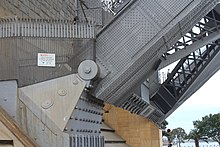

A hinged arch bridge is one with hinges incorporated into its structure to allow movement. In structural engineering, a hinge is essentially a "cut in the structure" that can withstand compressive forces. In a steel arch the hinge allows free rotation,[2] somewhat resembling a common hinge. The most common hinged arch bridge varieties are the two-hinged bridge with hinges at the springing points and the three-hinged bridge with an additional hinge at the crown of the arch; though single-hinged versions exist with a hinge only at the crown of the arch. Hinges at the springing point prevent bending moments from being transferred to the bridge abutments. A triple-hinged bridge is statically determinate, while the other versions are not.
- ^ Fernández Troyano, Leonardo (2003). Bridge Engineering: A Global Perspective. Thomas Telford. p. 287. ISBN 978-0-7277-3215-6.
- ^ Slivnik 2013, p. 1089.
© MMXXIII Rich X Search. We shall prevail. All rights reserved. Rich X Search


